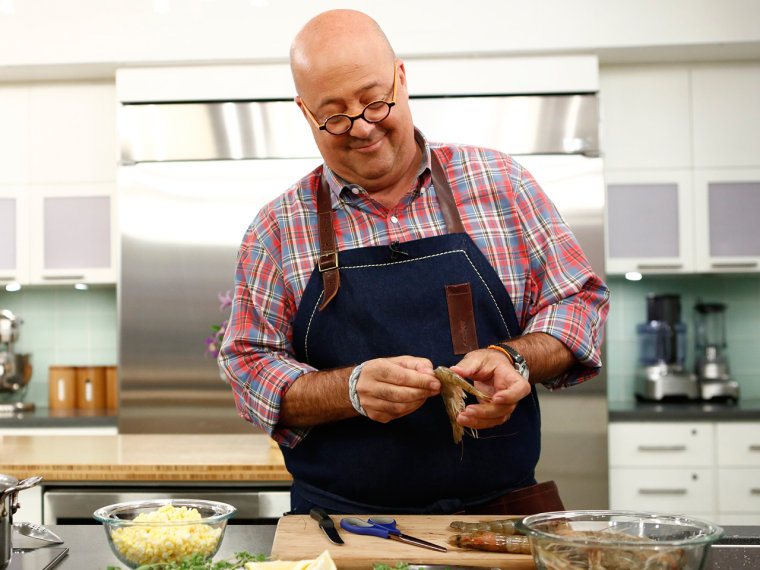Andrew Zimmern has famously ingested various animal parts, insects and dishes traditional Americans may consider unappetizing. But the “Bizarre Foods” host wants to change the way we look at food, and get us thinking beyond packaged and unhealthy fast food. The tougher question involves how we get our kids to start thinking that way. His latest book, “Andrew Zimmern's Field Guide to Exceptionally Weird, Wild, and Wonderful Foods,” takes on that challenge. Here, he talks to TODAY.com about some golden rules for encouragingyour children tobeadventurous, curious eaters.
Set a good example.
“Kids are not genetically encoded for only eating chicken nuggets and white toast,” said Zimmern. “There [are] whole cultures of children who get raised eating very healthfully and have ever seen macaroni and cheese. What happens is as parents we fall into traps because we’re all so time-poor. We live in a convenience-based society and we allow the message of our culture to get to our kids before our parental message gets to our kids. When society tells us, “Oh, that food is gross,” or “How could you eat liver? It’s terrible,” that teaches kids to practice contempt prior to investigation. And I think if we get to them before the cultural messaging gets to them, they become open-minded un-finnicky eaters. I’ve run test cases on children in my family; I know this works.
“We took [my son Noah] on the road with me pretty early, so he was eating guinea pig in Ecuador and beef cheek tacos pulled right off a steer head in Mexico and crazy things out of the water, clams and oysters on the half shell when he was a year old. We just threw him right in the deep end of the pool! Kids take their cues from their parents, so if parents sit around saying ‘Eww, that’s gross,’ their children will be the same way.”
Get kids to think critically
“We play a great game,” said Zimmern. “There’s a mason jar on our dining room table filled with questions … and we put food questions in there, around food insecurity and hunger issues, things like that. We started out when Noah was 2, and it’s not all serious doom and gloom, but we do put some serious questions in there, and he’s now a fully acculturated, politicized 8-year-old who not only understands the way the world works with food, but he understands how his body works with food. He understands the way the body metabolizes sugar, in simple terms that a little kid can, and knows about the nutrients his body needs.”
Make it pretty.
The last thing you want is to serve up something healthy and “foreign,” only to have your kid picked on in the lunchroom for eating something weird. Zimmern says packaging can help counter that. “As parents, we need to bag it up in a way that’s a little more appealing. We all eat with our eyes and children are no different. So if you put an old tuna fish sandwich in a dirty piece of wax paper, in a brown paper bag and send it off with your kid, chances are, he’s not going to have a good reaction when he looks to his right and sees little Benji with his chocolate pudding and everything else that Benji’s mom puts in there.
“We go to great lengths to make the trip to Target to get the cool new lunchbox every year to pack his lunch, and we’re really fond of those plastic Tupperware inserts that have freezer bottoms on them, so the food stays cold -- it makes it more appealing for him when cold things stay cold.”
A little fear goes a long way.
“Noah’s fascination with fast food ended when I went online and hunted down one of those stories about the germs that are on the slide at the playpen that they have at the fast food burger place (you know, the one that has the clown),” Zimmern said with a smirk. “They did this study that basically said there are staph infections there that can kill your kid. The media reports were a little fantastic, but I showed that to Noah – it worked like a charm! While he loves fast food burgers, he’s a little germophobe, so I hit him where it hurts with the germ message. But this is why we put those questions in the jar on the table. He understands that these companies use ammoniated pureed beef slurry, he understands that because we talk about these bits of news as they come into our consciousness. He loves fast burgers, but he just doesn’t get fastfood burgers.”
Zimmern isn’t the only one to use the fear tactic. Anthony Bourdain wrote in his 2010 memoir “Medium Raw” about counteracting big food propaganda with some propaganda of his own: scaring his daughter away from fast food by insinuating that Ronald McDonald was a kidnapper.
